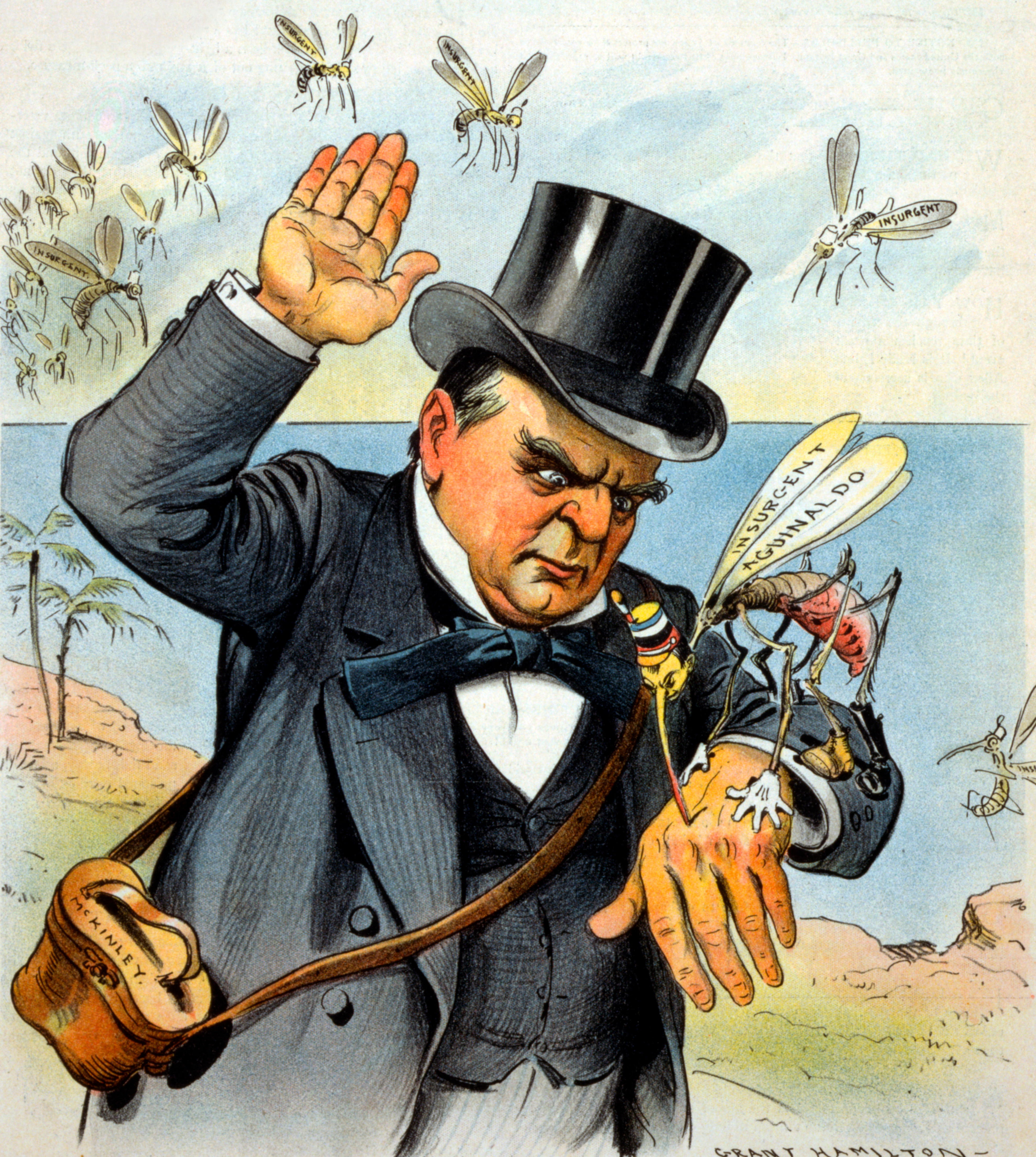Where exactly are we in the food chain? Are we the masters of this planet, or are we all just a canapé for the mosquito – the only organism to have killed more of us than even us?
Thanks to new scientific developments, an end to this mosquito-on-human genocide might not be far off – if, that is, we choose to pull the trigger on a new manmade extinction technology. But certainly, for as long as the history books go back, the mozzies have come out on top.
Videos by VICE
Everywhere humans have gone, our migration patterns have been constrained by the mosquito. It killed Pope Urban VII, Tutankhamun, Alexander the Great and Lord Byron. Even Oliver Cromwell succumbed to malaria, though this was supposedly as much to do with the fact he refused to drink quinine – the only available treatment – because he associated it with its Catholic inventors, proving yet again that sectarianism is the only force deadlier than disease.
Mosquitoes also shaped the history of Britain. The hugely expensive failure of a Scottish attempt to colonise the modern-day Panama – with half the would-be colonists succumbing to malaria – bankrupted the Scottish treasury, which, in turn, was why Scotland then agreed to the Union with England three years later, in 1702.
During the US War of Independence, British Redcoats squelching through the swamps of Georgia had a nasty habit of dying in numbers far greater than their local adversaries – a habit that may have been decisive in their eventual defeat. Not that mosquitoes didn’t kill Americans too, or tip the scales in other conflicts. The US Civil War killed 620,000, but soldiers were still five times more likely to die from malaria than in battle.

In short, there is an unseen force-field ringing a third of the world that repels human habitation, and that force-field is called mosquitoes. Why is South Africa the only territory on the continent with mass European settlement? In large part because, above the Tropic of Capricorn that begins at its northern border, they tried, and then they died. A genetic variation in haemoglobin shape called “sickle cell” is endemic in African populations. It affords some protection from the worst of malaria – but it also makes these populations uniquely vulnerable to a deadly form of anaemia.
And “protection from the worst” is still the best we can hope for. Twenty-five years ago, malaria was killing 3 million people a year. Even today, mainly due to better netting, half a million still perish every year, with 100 million becoming ill.
All vaccines have so far proved ineffective, and attempts to cure malaria through pharmaceuticals have long since stalled. The best thing we have is anti-malarial drugs – which are either hugely expensive (Malarone costs around £3 per tablet) or have ghastly side-effects (Lariam, which the British Army had to stop giving to its soldiers after it was linked to paranoia, deep depression and suicides). That taking these pills is a price worth paying tells you all you need to know about the savagery of malaria.
Of the 30 types of mosquito that can spread everything from dengue fever to yellow fever to Zika, the anopheles gambiae is our malaria mosquito. It likes to live near humans. It prefers human blood to all other types.
If the world gets any warmer we may have another billion people living within bombing-range of malarial mosquitoes (there is some recent evidence suggesting the world may be getting warmer). At which point, it’s easy to wonder why the suckers aren’t already dead. After all, we have a prodigious capacity to decide the fate of species, from passenger pigeons to marsupial lions to white rhinos.
The story of why we haven’t already killed off the 30 varieties of mosquito that are carriers for disease is simple: they breed like flies. Even if you deliberately introduce a disease into an animal population, you often end up simply breeding immunity into the population.
The most famous example is rabbits and myxomatosis, which was deliberately introduced to kill off Australia’s invader populations in 1950. It killed hundreds of millions of rabbits – 99 percent of them – unfortunately thereby creating a new rabbit master race of the 1 percent, which were genetically resistant. The population soon surged back.
But now, thanks to new techniques, we might be able to short-circuit that inbuilt resilience.
In July, a team at Imperial College London published the first results of their work investigating the mosquito problem. Within their labs, they’d achieved “the first-ever annihilation of a population of animals via ‘gene drive’” – taking thousands of mosquitoes living happily in glass boxes and turning their world into an entomological Children of Men, until there was not a single beastie left.
This “gene drive” solution flouts the normal rules of genetics. Normally, half of all traits come from each parent, but with gene drive nearly all offspring get the same modification. Imperial’s modification makes the females slightly more male – with a male mouth, so it can’t bite, and deformed reproductive organs, so they can’t lay eggs. As more and more female mosquitoes inherit two copies of the new gene, more and more become sterile. The trick, then, is to get in fast, and kill fast, and snuff out the complete set before random chance has time to breed immunity.
What’s driven Imperial’s spurt of progress has been progress on another kind of tech. Something called “CRISPR”, which first became news around 2005, but has become much more sophisticated within the past few years. CRISPR is an open-ended gene-editing technique – a bit like Minecraft, but for genes (and so complicated, reading the Wikipedia pagec will slice your brains to bits). The CRISPR technique was what China’s He Jiankui used late last year to alter the DNA of twin girls who became the world’s first genetically-engineered humans.
Meanwhile, on the other side of the Atlantic, another company is enjoying its own spurt of progress by using a similar mode of attack. A hundred miles south of San Francisco, the trucks of Google subsidiary Verily now regularly sputter around the suburban sprawl of the city of Fresno. At intervals decided by an algorithm, these trucks fart out mosquitoes, the exact quantity counted by a laser.
Verily is focused on the gambiae’s cousin, the Egyptian Mosquito, using a modified bacteria to render the males they release infertile so that, after all the elaborate courtship rituals proceed as normal, the female’s eggs never actually hatch. In the past two years, Google’s “Debug” project has delivered 200,000 brand new lab-grown mosquitoes a season to the no-doubt-delighted residents of Fresno. As these genitally-deformed mosquitoes have entered circulation, the overall mosquito population has dropped by 95 percent.
Suddenly, these schemes are bearing real fruit. Just last month, adapting many of the Fresno team’s techniques, a group of Chinese scientists in Guangzhou published the findings of a trial involving releasing 200 million genetically-modified Asian Tiger Mosquitoes, which carry dengue fever and Zika: they tanked populations by an unprecedented 90 percent.
It seems as though the question of “Can we destroy the mosquito?” is fading into history. Increasingly, science must answer the next question: “Should we?” This would be our first ever deliberate mass-extinction, after all. Quite a precedent.
Many seem perfectly content to pull the trigger. “If we eradicated them tomorrow, the ecosystems where they are active will hiccup and then get on with life,” leading entomologist Joe Conlon told the science journal Nature. “Something better or worse would take over.” Which is great, so long as it is “something better”.
Most in the ecology world seem to be surprisingly phlegmatic about losing the gambiae.
EO Wilson, perhaps the most famous biologist of modern times, has been remarkably unsentimental on the question. It’s just common sense, he suggests: “I’m talking about a very small number of species that have co-evolved with us and are preying on humans, so it would certainly be acceptable to remove them.”
Even asking the question seems to come loaded with a tincture of racism. If malaria were killing half a million North Americans every year, would we really be hemming and hawing over the question of what wiping them out might do to the ecosystem? Would we even be wasting time doing what the Imperial team have just begun: a four-year close study, in Ghana, of the gambiae’s life-cycle?
The law of unintended consequences looms large here. Just as mosquitoes determined human settlement patterns, so too will their absence. Territories that had previously seemed uninhabitable can be readied for farming, or for forestry.
“There is the opportunity for an ugly blowback,” says Dr Erica McAlister, of the Natural History Museum. “If you get rid of an animal in a specific ecological niche, more often other species will come in, and these may be other mosquito species, and so the cycle would start again. If not other mosquitoes, then you are more than likely to get a population explosion of either Chironomidae [non-biting midges] or Ceratopogonidae [biting midges].”
Not all mosquitoes are bad, either. In the arctic tundra, for instance, the mosquito is a key pollinator. There are entire species of orchids that rely on mosquitoes for their fertilisation.
Mara Lawniczak is an evolutionary geneticist and group leader at the Wellcome Sanger Institute, which is dedicated to “tackling some of the most difficult challenges in genomic research”.
“At this stage, targeting the worst vector species would make an enormous difference,” she suggests. “But yes, over time, if that was successful, other vector species would also need to be targeted or the risk would remain that malaria would rebound with population growth of one of the more minor species.”
It’s also possible that we won’t need to kill off anopheles gambiae entirely. Perhaps, once the mosquito population falls below a certain threshold, malaria parasites will naturally die out if they can’t sustain their own transmission.
“Gene drive is not resistance-proof,” warns Lawniczak. “More recent versions are improved, and take into account more variables. But this will not be a simple ‘release the magic bullet once and watch malaria disappear’. It will continue to be a war, with regular surveillance and new tactics needed frequently.”
Then there’s the issue of the other animals, whose lives are also conditioned by the mosquito. Caribou migration routes, for instance, are designed to avoid mosquitoes, so there are knock-on effects for all those species that feed on passing caribou.
Beyond these, there’s the natural justice problem: the fact that we’re punishing a species for the crimes of a disease. It’s malaria, not mosquitoes, that’s the problem.
Earlier this year, the government of Burkina Faso green-lighted a limited trial with the Imperial research team, to introduce a “sterile male mutation” into the population. In other words, a gene drive – but a time-limited one, restricted to a single year.
The fate of the gambiae isn’t in the hands of Western research teams, after all – it’s the national governments of African countries who get to decide what happens on their turf, and getting them all to row in the same direction at the same time may prove the hardest task.
Still, now that we’re fully in the driving seat of evolution, perhaps we can at least console ourselves by imagining a niche is opening up for something cuter, something fluffier: big-eyed and bushy-tailed. Something more us.
More
From VICE
-

Screenshot: Sony Interactive Entertainment -

-

LOS ANGELES, CALIFORNIA – NOVEMBER 14: Timothée Chalamet seen at a Special Screening of A24's "Marty Supreme" at Academy Museum of Motion Pictures on November 14, 2025 in Los Angeles, California. (Photo by Eric Charbonneau/A24 via Getty Images) -

Photo: Gandee Vasan / Getty Images
